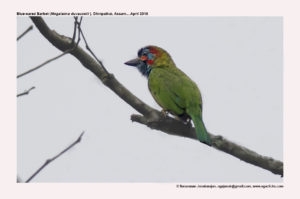Blue Eared Barbet

Blue-eared Barbet: Megalaima australis
Etymology :
- Megalaima: Greek word megalos- great; laimos- throat. { Great Throat}
- Australis: Southern
Vernacular Names : Cachar: Dao tukra kashiba
Distribution in India: Resident of Eastern Himalayan Foothills and North East India.
Description: Size of 16–17 cm; Wt. of 31·6–39·5 g. It is a small, green, stout-billed barbet with blue crown and throat, and very narrow black band between throat and breast. Races differ mainly in detail and colours of head and breast patterns, variation complex, all lacking yellow on ear-coverts. Sub-species orientalis is slightly larger and paler overall, commonly with narrow red patch across upper breast.
Habitat: It is found in primary forest and edges in lowlands and foothills; mainly evergreen forest, plantations, gardens, bamboo and deciduous forest. It is found up to 1200 m.
Food habits: It eats fruits like figs and insects. It also feeds with pigeons and other species.
Breeding habits: They breed in Jan–Aug in India; from Jan in Vietnam and Mar–Sept in Thailand. They sing incessantly, pair-members simultaneously. Courtship displays include head-bobbing, side-to-side tail movement in aggressive, courtship-feeds fruits repeatedly before copulation. The nest is excavated in dead trunk or branch, often on underside of branch, .They may excavate in old woodpecker hole. They lay a clutch of 2–4 eggs.